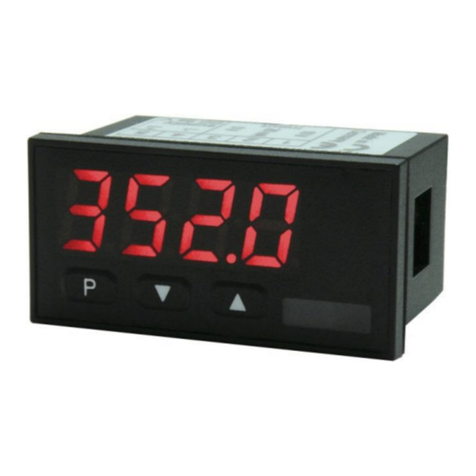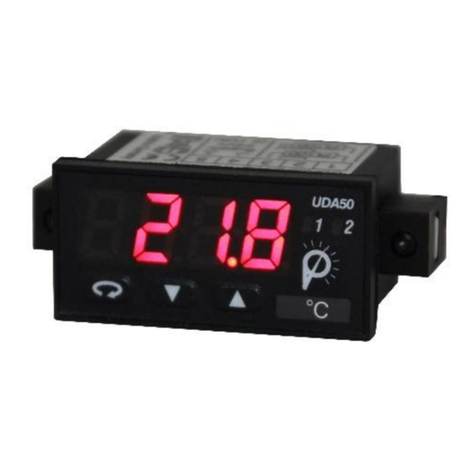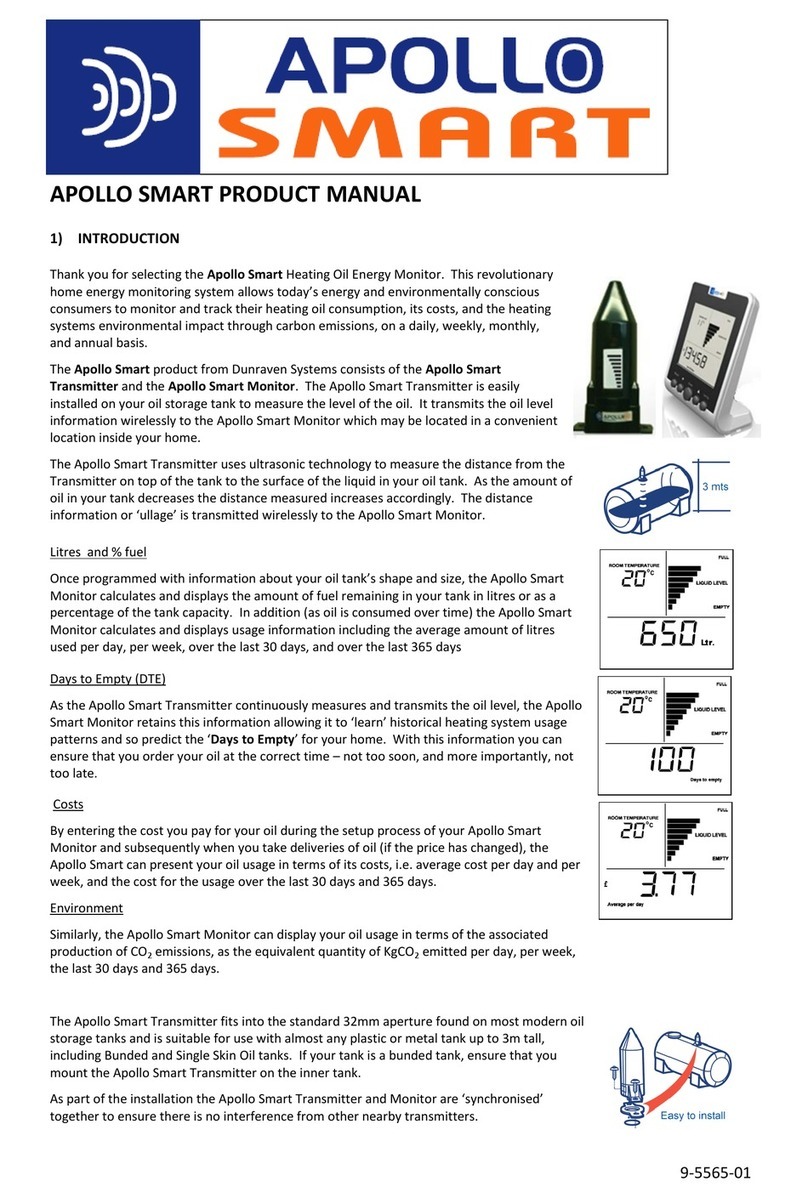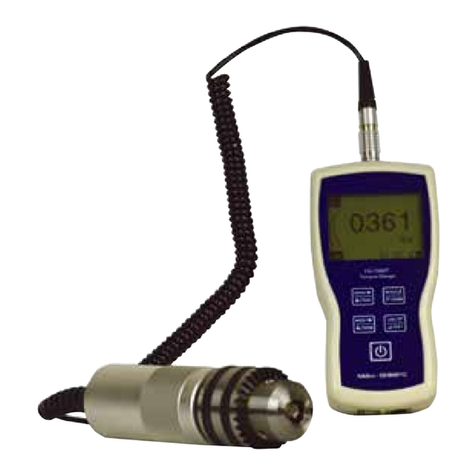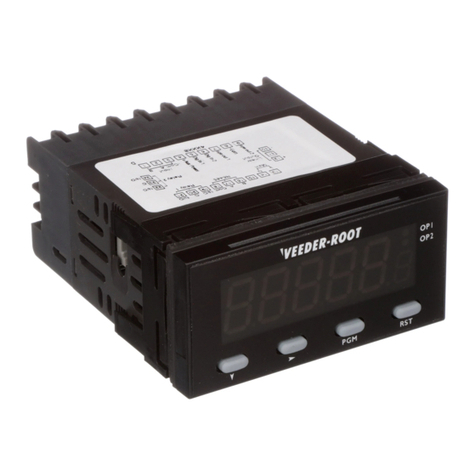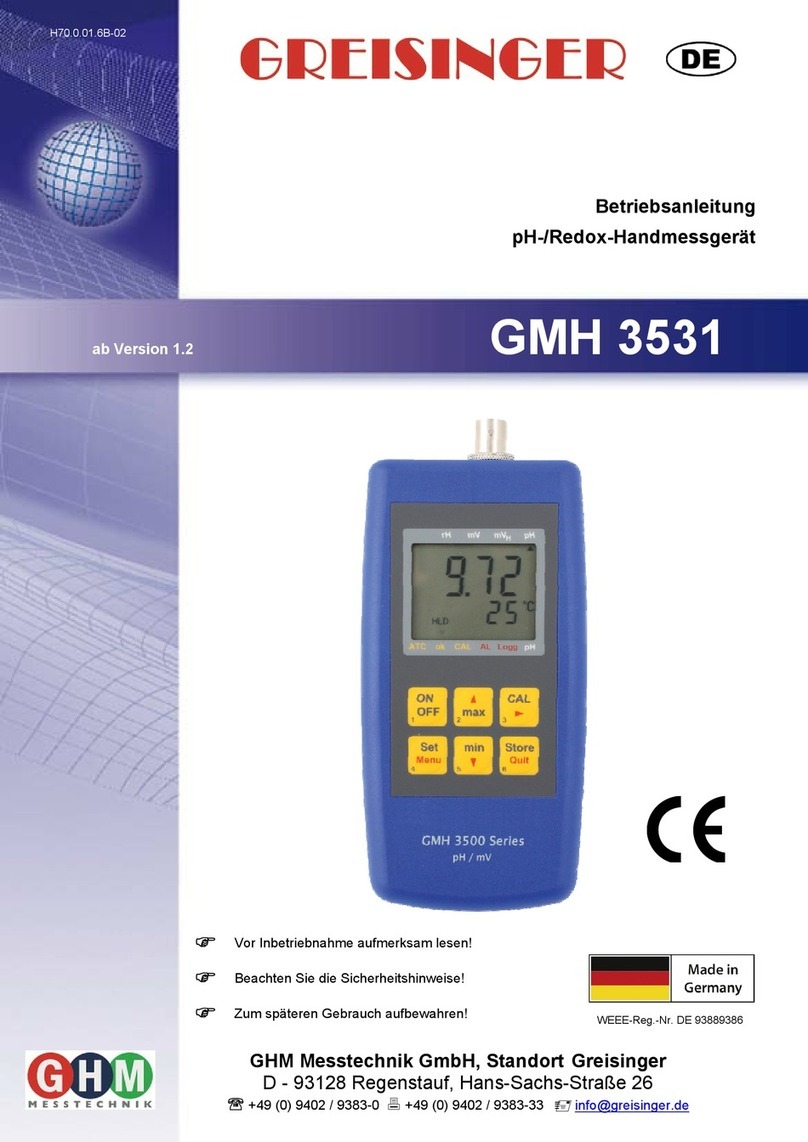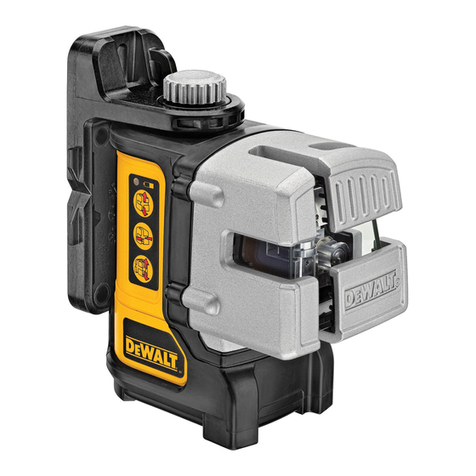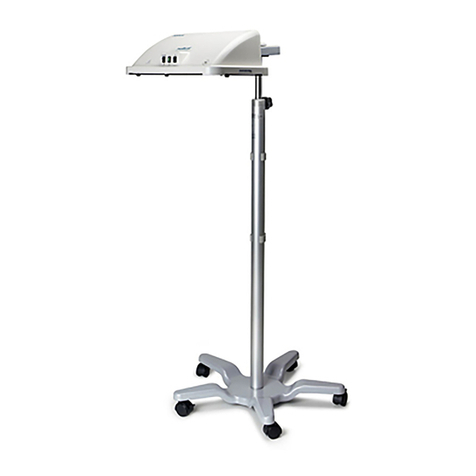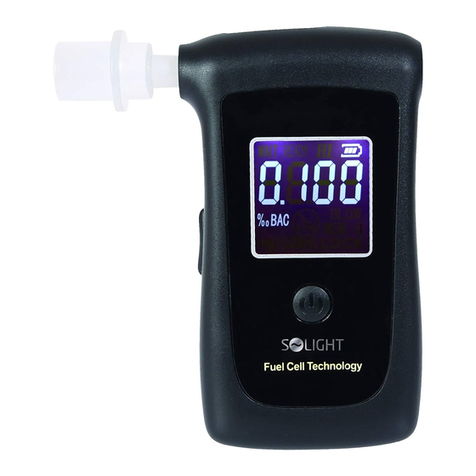promesstec MDW 500 User manual

promesstec GmbH I Niedersachsenstraße 4 I D-48465 Schüttorf I Tel.:+49 (0)5923/ 90 229 0 I Fax:+49 (0)5923/ 90 229 29
E-Mail: office@promesstec.com I Internet: www.promesstec.com
User manual
Flow meter MDW / MDH 500
version 2.1.1

2
promesstec GmbH I Niedersachsenstraße 4 I D-48465 Schüttorf I Tel.:+49 (0)5923/ 90 229 0 I Fax:+49 (0)5923/ 90 229 29
E-Mail: office@promesstec.com I Internet: www.promesstec.com
Content
1. General................................................................................................................ 4
1.1 Description measuring principle......................................................................4
1.2 Drawings, shortcut..........................................................................................4
2. Transport, Packaging, Storage............................................................................ 5
2.1 Transport........................................................................................................5
2.2 Packaging.......................................................................................................5
2.3 Storage...........................................................................................................5
3. Safety instructions.............................................................................................. 5
3.1 Intended use of the product............................................................................5
3.2 Stuff qualification............................................................................................6
3.3 Special hazards..............................................................................................6
4. Starting, operation.............................................................................................. 7
4.1 feature............................................................................................................7
4.2 Installation in pipeline.....................................................................................7
4.3 Outdoor conditions .........................................................................................7
4.4 Disturbance sources.......................................................................................7
4.4.1 Vibrations.................................................................................................8
4.4.2 Proper location.........................................................................................8
4.4.3 Installation examples ...............................................................................9
4.4.4 Recommendation...................................................................................10
4.4.5 Compact construction of the meter........................................................10
4.4.6 Installation in pipeline.............................................................................11
4.5Wiring...........................................................................................................19
4.5.1 Meter wiring ...........................................................................................19
4.5.2 Assignment M12 plug ............................................................................21
4.6 Power supply cover sheet ............................................................................22
4.7 Impulse output / Flow Switch contact OUT1 / OUT2 ....................................23
4.8 Current output...............................................................................................25
4.9 Control input.................................................................................................26
4.10 Data output...................................................................................................26
4.11 Protection degree.........................................................................................26
4.12 Replacement of tube fuse in the meter.........................................................27
4.13 Wiring check.................................................................................................27
5. Putting into operation........................................................................................ 28

3
promesstec GmbH I Niedersachsenstraße 4 I D-48465 Schüttorf I Tel.:+49 (0)5923/ 90 229 0 I Fax:+49 (0)5923/ 90 229 29
E-Mail: office@promesstec.com I Internet: www.promesstec.com
5.1 Meter status..................................................................................................28
6. Technical specifications.................................................................................... 29
6.1 Factory settings............................................................................................31
6.2 Adjusting and control of the meter MDW/ MDH 500.....................................32
6.3 Instruction manual MDW / MDH 500............................................................33
7. Application information..................................................................................... 65
7.1 Disassembly and assembly of PCB..............................................................66
7.2 Basic sensor sizes........................................................................................67
7.3 Reduction in DN pipe....................................................................................71
7.4 Faults and their symptoms during measurement..........................................71
8. Dismounting, Return, Cleaning, Disposal......................................................... 72
8.1 Dismounting .................................................................................................72
8.2 Return...........................................................................................................72
8.3 Cleaning.......................................................................................................72
8.4 Disposal........................................................................................................72

4
promesstec GmbH I Niedersachsenstraße 4 I D-48465 Schüttorf I Tel.:+49 (0)5923/ 90 229 0 I Fax:+49 (0)5923/ 90 229 29
E-Mail: office@promesstec.com I Internet: www.promesstec.com
1. General
1.1 Description measuring principle
The MDW/MDH 500 meter is based on measurement principle by a well-known Far-
aday's electromagnetic induction law according to which an electric voltage is in-
duced during the flow of a conductive liquid through the flow meter magnetic field.
This is picked up by two electrodes in direct contact with the measured medium and
evaluated in the electronic unit.
The MDW/MDH 500 type of induction meters are suitable exclusively for measure-
ment of volumetric flow of electrically conductive liquid substances with a minimum
conductivity of 20 µS/сm (at a lower conductivity, upon agreement with the manu-
facturer).
Meters are designed for flow measurement where the velocity of liquid is in the range
of 0.01 - 12 m/s. The best measurement accuracy can be obtained in the range of
1 - 10 m/s.
1.2 Drawings, shortcut
Warning!
A non-observance can cause injuries to persons and/or the demoli-
tion of the device. There can be a dangerous to life.
Attention!
A non-observance can cause a faulty operation of the device or lead
to property damage.
Information!
Information!
A non-observance can have influence on the operation of the device
or cause unintentional reactions of the device.
Danger!
When not observing the safety instructions, there is a risk of serious
or fatal injuries caused by electrical power.
Warning!
Possibly a dangerous situation can occur, which results in burns be-
cause of hot surfaces or liquids, if not avoided.
Flow meter MDW/ MDH 500

5
promesstec GmbH I Niedersachsenstraße 4 I D-48465 Schüttorf I Tel.:+49 (0)5923/ 90 229 0 I Fax:+49 (0)5923/ 90 229 29
E-Mail: office@promesstec.com I Internet: www.promesstec.com
2. Transport, Packaging, Storage
2.1 Transport
Check the instrument for any damage that may have been caused during transpor-
tation. If, report them immediately. The temperature during transportation and stor-
age of the meter must be within the range of -10 °C to 50 °C.
2.2 Packaging
Do not remove packaging until just before mounting. Keep the packaging as it will
provide optimum protection during transport (e.g. change in installation site, sending
back).
2.3 Storage
For longer term storage avoid the following influences:
1. Direct sunlight or proximity to hot objects
2. Mechanical vibration, mechanical shock (putting it hard down)
3. Soot, vapour, dust and corrosive gases
If possible store the device in its original package or an equivalent one
3. Safety instructions
More important safety instructions can be found in the individual
chapters.
3.1 Intended use of the product
The sensor has been designed and built solely for the intended use described here
and may only be used accordingly. The technical specifications contained in these
operating instructions must be observed. Improper handling or operation of the in-
strument outside of its technical specifications requires the instrument to be taken
out of service immediately and an inspection by the manufacturer. When the instru-
ment is transported from a cold into a warm environment, the formation of conden-
sation may result in the instrument malfunctioning. Before putting it back into oper-
ation, wait for the instrument temperature and the room temperature to equalise.
The manufacturer shall not be liable for claims of any type based on operation con-
trary to the intended use.

6
promesstec GmbH I Niedersachsenstraße 4 I D-48465 Schüttorf I Tel.:+49 (0)5923/ 90 229 0 I Fax:+49 (0)5923/ 90 229 29
E-Mail: office@promesstec.com I Internet: www.promesstec.com
3.2 Stuff qualification
Improper handling can result in considerable injury and damage to
equipment. The activities described in these operating instructions
may only be carried out by skilled stuff who have the qualifications
described below. Keep unqualified stuff away from hazardous areas.
For installation and starting of the flow-meter the stuff has to be familiar with the
relevant regulations and directives of the country and must have the qualification
required. They must have knowledge on measurement and control technology, have
to be acquainted with electric circuits, are capable of carrying out the work described
and can independently recognize potential hazards. Depending on the operation
conditions of the application they have to have the corresponding knowledge, e.g.
of aggressive media.
3.3 Special hazards
For hazardous media such as oxygen, acetylene, flammable or toxic
gases or liquids, refrigeration plants, compressors, etc., in addition to
all standard regulations, the appropriate existing codes or regulations
must also be followed. If you do not observe the appropriate reg-
ulation, serious injuries and/or damage can occur!
A protection from electrostatic discharge (ESD) is required. The
proper use of grounded work surfaces and personal wrist straps is
required when working with exposed circuitry (PCB, printed circuit
boards), in order to prevent static discharge from damaging sensitive
electronic components.
There is a danger of death caused by electric current. Upon contact
with life parts, there is a direct danger of death. Electrical instruments
may only be installed and connected by skilled electrical personnel.
Operation using a defective power supply unit (e.g. short circuit from
the mains voltage to the voltage output) can result in life-threatening
voltages at the instrument.
Residual media in dismounted instruments can result in a risk to per-
sonnel, the environment and equipment. Take sufficient precaution-
ary measures. Do not use this instrument in safety or Emergency
Stop devices. Incorrect use of the instrument can result in injury.
Should a failure occur, aggressive media with extremely high tem-
perature and under high pressure or vacuum may be present at the
instrument.

7
promesstec GmbH I Niedersachsenstraße 4 I D-48465 Schüttorf I Tel.:+49 (0)5923/ 90 229 0 I Fax:+49 (0)5923/ 90 229 29
E-Mail: office@promesstec.com I Internet: www.promesstec.com
4. Starting, operation
4.1 feature
4.2 Installation in pipeline
In case of detached design, the cable must not be extended or cut
short.
4.3 Outdoor conditions
It is necessary to ensure that the flow sensor is not exposed to weather effects and
that the measured medium cannot freeze in the flow sensor as it would damage the
measuring tube.
In case of outdoor location of the electronic evaluation unit, the manufacturer rec-
ommends using a protective box or a roof to avoid direct solar exposure so that the
evaluation electronics cannot get overheated.
4.4 Disturbance sources
These are the sources disturbing the steady flow of a liquid:
-Pumps and bends or elbows located closely in series in various planes.
These elements should be at a distance of at least 20´d (“d” stands for inside
diameter of the sensor in mm) before the flow sensor.
-Sudden variations in the pipe sectionunless constructedas a cone with angle
α ≤ 16° (where αis the angle between the bevelled walls of the pipe adapter).
-Incorrectly centred seal, the seal with a mall internal diameter, or the seal
made of soft elastic materials which penetrate into internal section of the pipe
after the flanges have been tightened.
-Anything that interferes with the flow of liquid, e.g. the thermometer well.
-Branches, T-pieces, bends, elbows, slide valves, taps, and throttles. Shut-off
valves, control valves, butterfly valves, and check valves. Pipe outlets from
tanks, heat exchangers, and filters.
No strong electromagnetic field must take effect close to the inductive flow sensor
(pick-up).

8
promesstec GmbH I Niedersachsenstraße 4 I D-48465 Schüttorf I Tel.:+49 (0)5923/ 90 229 0 I Fax:+49 (0)5923/ 90 229 29
E-Mail: office@promesstec.com I Internet: www.promesstec.com
4.4.1 Vibrations
We recommend you to support the connecting pipes at both sides of the meter to
partially eliminate vibrations. The level and range of vibrations must be below 2.2g
within frequency range of 20 - 50 Hz according to IEC 068-2-34 standard.
4.4.2 Proper location
The flow sensor must not be at the top of the pipeline where air intake occurs or in
the declining and also in horizontal pipeline with open end where air may penetrate.
Sedimentation of impurities may occur during a long-run measurement of very low
flow rates Q < 0.1 m/s. The site where the flow sensor is installed there must be a
sufficient pressure so that vapour or gas bubbles cannot be discharged from the
liquid. The tiny bubbles occurring in liquids all the time can accumulate at any of the
electrodes and they can cause incorrect function of the meter. The gas bubbles are
discharged from liquids also during a sudden drop of pressure. Therefore, the con-
trol butterfly valves and similar components should be inserted behind the flow sen-
sor. For the same reason, the flow sensor should not be installed at the suction side
of the pump. To prevent the bubbles from accumulating in the flow sensor while the
flow is slow, it is useful for the pipeline either to be slightly ascending or the sensor
is put into the vertical part of the pipeline.
If the meter is populated with measuring electrodes only (2 or 3 electrodes located
beyond the upper profile of the tube), itis necessary for proper function of the meter,
to fill up the flow sensor with the fluid to be measured so that erroneous measure-
ment of quantity of liquid passing through the meter can be avoided when the pipe
is empty. It is necessary to select the location of the meter in such a way that the
flow sensor aeration is avoided. In the case of an open system, the flow sensor is
placed in the bottom position of the U-profile, ensuring that the fluid will not flow out
of the sensor. In the case that the sensor is equipped with an empty pipe test elec-
trode (3rd or 4th electrode in the upper part of the measuring tube profile), there is
no risk of erroneous measurement of quantity of liquid passing through the meter
due to aeration of measuringelectrodes. This function must be activated in PARAM-
ETERS (EMPTY TUBE TEST) menu. If it be to the contrary, the same conditions
stand good as if the testing electrode is not populated.

9
promesstec GmbH I Niedersachsenstraße 4 I D-48465 Schüttorf I Tel.:+49 (0)5923/ 90 229 0 I Fax:+49 (0)5923/ 90 229 29
E-Mail: office@promesstec.com I Internet: www.promesstec.com
4.4.3 Installation examples
Trouble-free and exact operation of the meter is dependent on its correct location in
the system. The most frequent methods of the placement are shown in the following
figures:
Recommended installation locations Downtake pipe
Horizontally laid pipeline Long pipeline
Free inlet or outlet Pumps
Bubbles are accumulated in the
pipeline; erroneous measurement
Install an air bleed valve after
the sensor
Place the sensor in a slightly as-
cending pipeline
Pipeline is
empty; er-
roneous
measure-
ment
Correct loca-
tion
Install controls and shut-off valves al-
ways after the sensor
Built in the U-shaped pipeline
The flow meter must not be installed in the
suction side of the pump

10
promesstec GmbH I Niedersachsenstraße 4 I D-48465 Schüttorf I Tel.:+49 (0)5923/ 90 229 0 I Fax:+49 (0)5923/ 90 229 29
E-Mail: office@promesstec.com I Internet: www.promesstec.com
The flow of liquid flow in the flow sensor should be steady and free of whirling. For
this reason, straight sections of pipeline with the same ID as that of the flow meter
before and after the flow sensor (with permissible deviation of +5%). Recom-
mended minimum length of straight sections is 5xd before the flow sensor and 3xd
after the flow sensor where d is the inside diameter of the meter in millimetres. The
same principles apply before and after the flow sensor in case of bi-directional flow
measurement.
4.4.4 Recommendation
When the flow is whirled up, increase the stabilizing sections of the pipe or install
the flow conditioner. When mixtures are blended, it is necessary to install the flow
meter either before the blending spot or at a sufficient distance behind it (30xd min.)
otherwise it may result in unstable readouts. The grounding rings are necessary
when plastic or metal pipes with the internal non-conductive layer are used.
4.4.5 Compact construction of the meter
For the compact design, the following points should be particularly noted:
- The maximum temperature of the medium (max. +90° C, attention see here-for
data sheet Lining). If the temperature is exceeded, this can lead to a faulty meas-
urement or even to the destruction of the device. With the PTFE-lining CIP-clean-
ing processes are possible.
- When installing the device, do not pick up or hang up the flow meter on the eval-
uation unit (connection head).
- If the flowmeter is exposed to high vibrations, do not use a compact version.
The user is responsible for the proper use of the meter.

11
promesstec GmbH I Niedersachsenstraße 4 I D-48465 Schüttorf I Tel.:+49 (0)5923/ 90 229 0 I Fax:+49 (0)5923/ 90 229 29
E-Mail: office@promesstec.com I Internet: www.promesstec.com
4.4.6 Installation in pipeline
The inductive flow sensor is installed in arbitrary position in vertical piping. In case
of horizontal piping, it is necessary to make sure that the sensor is installed with its
measuring electrodes in horizontal position. In case of the earthing electrode design,
possibly with testing for empty pipeline, then the installation is always performed
with the earthing reference electrode facing down (with the sensor terminal box,
eventually with the evaluation unit facing upwards). Then the earthing reference
electrode is in the bottom position and the empty tube sensing electrode is in the
top position of the flow sensor.
Every time when the empty tube testing electrode is not covered with a liquid for
5sec at least, the flow meter will display the "Empty tube" status, and if it is neces-
sary, it sends out an error message and stops taking measurement. The measure-
ment accuracy is maintained in this way. Once the electrode is covered with the
liquid again, the error message disappears and the flow meter starts taking meas-
urement again.
Installation in piping and placement of measuring electrodes in flow sensor.

12
promesstec GmbH I Niedersachsenstraße 4 I D-48465 Schüttorf I Tel.:+49 (0)5923/ 90 229 0 I Fax:+49 (0)5923/ 90 229 29
E-Mail: office@promesstec.com I Internet: www.promesstec.com
The measurement accuracy is maintained in this way. Once the electrode is covered
with the liquid again, the error message disappears and the flow meter starts taking
measurement again.
Measurement error caused by incorrect mounting installation
1) correct installation (flow sensor should be install in arbitrary position in vertical
piping)
EMPTY TEST –ON EMPTY TEST –OFF
2) incorrect installation (placing the unit diagonally, Empty test –ON)

13
promesstec GmbH I Niedersachsenstraße 4 I D-48465 Schüttorf I Tel.:+49 (0)5923/ 90 229 0 I Fax:+49 (0)5923/ 90 229 29
E-Mail: office@promesstec.com I Internet: www.promesstec.com
- in the version without the earthed reference electrode and/or empty piping
test (2 electrodes)
- in the version with earthed electrode and/or empty piping test electrode (3/4 of
the electrode)

14
promesstec GmbH I Niedersachsenstraße 4 I D-48465 Schüttorf I Tel.:+49 (0)5923/ 90 229 0 I Fax:+49 (0)5923/ 90 229 29
E-Mail: office@promesstec.com I Internet: www.promesstec.com
The installation is carried out by fixing it between the counter flanges (sandwich)
welded on the calming pipe (5D before, 3D behind and downstream) whereas the
liquid must flow through the flow sensor in the direction indicated on it with an arrow.
When counter flanges are being welded on the pipe, it is essential to maintain their
alignment so as to ensure uniformity of seating faces of the flanges on the face
areas of the sensor (however, this must not be reached by uneven tightening of the
connecting bolts because there isa risk of leakage resulting from temperature strain
in the future and, in some case, the measuring tube might crack when being tight-
ened unevenly). The difference in LMAX and LMIN distances of the both sealing
faces on the flanges before the flow sensor is installed, must not be longer than 0.5
mm.
In the same way, the mating positions of holes for connecting bolts in counter-
flanges should be ensured as well as ample room behind the flanges for the con-
necting bolts and nuts in order to ensure proper installation of the sensor in the pipe
and the attachment by connecting bolts.
The manufacturer recommends using a fitting adapter for welding. It is absolutely
inadmissible to use the flow meter as a fitting adapter due to possible thermal de-
struction. The welding current must not flow through the flow sensor during electric
welding. The installation of the flow sensor itself is carried out after all welding, paint-
ing, building, and similar jobs are finished.
If the flow sensor has a fibre-rubber sealing, it is inevitable to lubricate it using graph-
ite grease or oil with graphite.

15
promesstec GmbH I Niedersachsenstraße 4 I D-48465 Schüttorf I Tel.:+49 (0)5923/ 90 229 0 I Fax:+49 (0)5923/ 90 229 29
E-Mail: office@promesstec.com I Internet: www.promesstec.com
When a threaded connection is used, it is essential to check the thread on the sen-
sor, while it is being tightened, to prevent it from moving round a slight amount.
During installation, beware of:
-dropping the meter onto the ground and damaging the measuring tube or
electronics
-contamination of the electrodes (do not touch the electrodes, otherwise they
get contaminated)
-when additional sealing is used, avoid its interference in the flow profile of the
detector between the flanges and the pipeline, otherwise the flow measure-
ment error may be increased
Tightening torques
It is absolutely necessary to tighten the bolts and nuts equally by alternating sides
and in the order shown in figure applying the maximum torque according to the table:
Diameter
nominal
PN 10
PN 16
DN
Screws
Tightening torque
[Nm]
Screws
Tightening torque [Nm]
Rubber
PTFE
Rubber
PTFE
10
4 x M12
10
15
4 x M12
10
15
15
15
20
15
20
20
20
25
20
25
25
20
25
20
25
32
4 x M16
20
25
4 x M16
20
35
40
20
25
20
35
50
20
45
20
45
65
20
46
20
46
80
8 x M16
20
48
8 x M16
20
48
100
20
50
20
50
125
20
80
20
65
150
8 x M20
24
90
8 x M20
27
90
200
27
115
12 x M20
35
80
250
12 x M20
35
95
12 x M24
55
100
300
50
100
80
110
350
16 x M20
60
70
16 x M24
95
105
400
16 x M24
75
120
16 x M27
140
150

16
promesstec GmbH I Niedersachsenstraße 4 I D-48465 Schüttorf I Tel.:+49 (0)5923/ 90 229 0 I Fax:+49 (0)5923/ 90 229 29
E-Mail: office@promesstec.com I Internet: www.promesstec.com
Diameter
nominal
PN 25
PN 40
DN
Screws
Tightening torque
[Nm]
Screws
Tightening torque [Nm]
Rubber
PTFE
Rubber
PTFE
10
4 x M12
15
15
4 x M12
15
15
15
20
20
25
25
20
25
25
25
25
25
25
25
25
25
32
4 x M16
25
35
4 x M16
25
40
40
25
35
35
50
50
35
45
35
60
65
8 x M16
35
46
8 x M16
45
55
80
40
48
45
60
100
8 x M20
40
55
8 x M20
50
75
125
8 x M24
50
110
8 x M24
70
120
150
57
115
75
136
200
12 x M24
68
100
12 x M27
85
145
250
12 x M27
88
120
12 x M30
105
220
300
16 x M27
95
125
16 x M30
115
250
350
16 x M30
115
200
16 x M33
140
-
400
16 x M33
135
255
16 x M36
165
-
In case of using a corundum or thermoplastic tube, the same torques apply as in case
of using the PTFE tube according to the given pressure series.
Threaded connection (EN 10226-1):
Diameter nominal DN
Process connection [inch]
Tightening torque [Nm]
10
3/8”
8
15
½“
10
20
¾“
21
25
1“
31
32
1 ¼“
60
40
1 ½“
80
50
2“
5
65
2 ½“
6
80
3“
15
100
4“
14
The screws are tightened in three steps: first the screws are tightened to 50% of the
recommended torque, then to 80% and later to 100% of the maximum torque.
It is recommended to check the tightened screws within the next 24 hours.

17
promesstec GmbH I Niedersachsenstraße 4 I D-48465 Schüttorf I Tel.:+49 (0)5923/ 90 229 0 I Fax:+49 (0)5923/ 90 229 29
E-Mail: office@promesstec.com I Internet: www.promesstec.com
Grounding
Each flow sensor must be earthed. The earthing cable must not transmit the inter-
ference voltage, i.e. this cable must not be used for earthing other sensors at the
same time.
The sensor is equipped with a grounding screw, washer and nut made of stainless
steel M5. These must be connected to the earth cable. If it is not ensured that the
counter flanges are in direct contact with the measured liquid and are conductive, it
is recommended to use earthing rings.
Grounding rings - only if ordered.
The earthing rings are used when plastic pipes or metal pipes with internal plastic
coating are used. The conductive stainless steel rings provide a conductive connec-
tion with the measuring liquid. The sensor is equipped with an earthing screw and
earthing cable. This cable must be connected to the grounding rings for grounding.

18
promesstec GmbH I Niedersachsenstraße 4 I D-48465 Schüttorf I Tel.:+49 (0)5923/ 90 229 0 I Fax:+49 (0)5923/ 90 229 29
E-Mail: office@promesstec.com I Internet: www.promesstec.com
High temperature pipeline
If the temperature of the measuring liquid is higher than 100°C, it is necessary to
compensate for the forces caused by linear expansion. If a short tube is used, a
flexible seal should be used. If a long pipe section is used, flexible components such
as bends should be used.
Electrodes
The electrode material must be selected according to chemical resistance to the
liquid to be measured. The purity of the electrodes may have an influence on meas-
urement accuracy, their heavy foulness may cause even the interruption of the
measuring function (isolation from the liquid). It is not necessary to clean the elec-
trodes right after delivery before their installation in the pipeline. If the electrodes
indicate signs of foulness, clean them with a soft cloth or use a chemical cleaning
agent. Mind damaging to the lining! During routine operation, in case of a great ma-
jority of liquids, it is not necessary to clean the flow meter for the entire operation
period of the flow sensor; self-cleaning by flow of the liquid is sufficient (recom-
mended velocity is over 2 m/sec).
PTFE, PFA, EFTE lining
The installation is carried out at the lowest point of the pipes to avoid negative pres-
sure. The PTFE coating must not be damaged under any circumstances. The pro-
tective caps must not be removed until just before installation between the flanges.
Installation check
After installation of the flow sensor in the pipeline, the following must be checked:
-According to the name plate, if there is a relevant meter in the given
measuring point (pressure, temperature, dimension, etc.).
-If the direction of the arrow on the device is in agreement with the direc-
tion of the flow in the pipeline.
-Correct position of the measuring electrodes (horizontally).
-Correct position of the electrode for empty pipeline detection (up).
-If all bolts (screws) are tightened properly.
-If earthing rings are used, then their correct installation and connection
with the sensor.
-Accuracy of flow sensor earthing.
-Accuracy of execution of the pipeline calming section lengths
-If the sensor is protected against vibrations and mechanical damage.

19
promesstec GmbH I Niedersachsenstraße 4 I D-48465 Schüttorf I Tel.:+49 (0)5923/ 90 229 0 I Fax:+49 (0)5923/ 90 229 29
E-Mail: office@promesstec.com I Internet: www.promesstec.com
-If the name plate (serial number) on the sensor corresponds to the one
on the electronics.
4.5 Wiring
When the operations described below are performed unprofession-
ally, the claim on warranty becomes extinct!!! Prior to any opening
of the evaluation unit, switch off the power!!! It is necessary to bear
in mind that in case of detached design, the electronic evaluation
unit and the flow sensor form an integral unit which is calibrated and matched
uniquely. In consequence, make sure that the serial numbers of both parts are al-
ways identical!!!
4.5.1 Meter wiring
In case of a separate version, the connecting cable must not be shortened or ex-
tended.
The signal cable of the separate sensor must not be laid next to voltage distributors,
motor electromagnets, frequency converters or similar sources with electromagnetic
fields.
To ensure the tightness of the cover of the evaluation unit, the seal must be kept
intact and clean.
Evaluation unit
Standard power supply: 230V / 50 ÷ 60Hz
Other power supply possible: DC 24VAC / DC / 250mA
The signal inputs and outputs of the flow meter must only be connected with the
units where protection against personal injuries is ensured by safe voltage and
where generated voltages do not exceed limits specified for safe voltage. When op-
erated from 230V / 50÷60Hz mains, the meter is powered up using a switch-mode
power supply that may contain beat frequencies in acoustic spectrum, however, this
symptom does not indicate any malfunction of the meter.
The evaluation unit consists of two independent subunits:
-measuring element (front panel with display unit)

20
promesstec GmbH I Niedersachsenstraße 4 I D-48465 Schüttorf I Tel.:+49 (0)5923/ 90 229 0 I Fax:+49 (0)5923/ 90 229 29
E-Mail: office@promesstec.com I Internet: www.promesstec.com
-input/output and power supply board
Note: Connecting the terminal board is always described on the inner label placed
on the meter rear lid or the cover metal sheet of the power source.
Evaluation unit terminal board wiring:
Terminals No. 1, 2 current output 4÷20 mA
Terminals No. 3, 4 impulse output OUT IMP
Terminals No. 5, 6 RS485 communication
Terminals No. 7, 8 output 2
Terminals No. 9, 10 reset Total V register (resettable counter) by external
button
Terminals No.11, 12 output voltage 16 V/100 mA (power supply for changing
to active current and impulse outputs)
Terminals L, N, PE mains voltage 230 VAC (standard), available also in 24
VAC/VDC version (Install as an independent supply cir-
cuit with its own protection 0.5÷1 A)
Under no circumstances should the cabling form loops or similar.
A separate cable should always be used for the power supply.
Unused plugs should be secured with insulation or plastic cover.
This manual suits for next models
1
Table of contents
Other promesstec Measuring Instrument manuals
Popular Measuring Instrument manuals by other brands

Endress+Hauser
Endress+Hauser silopilot FMM 460 Installation and operating instructions

IN DEVICE
IN DEVICE Dallas 2 user manual
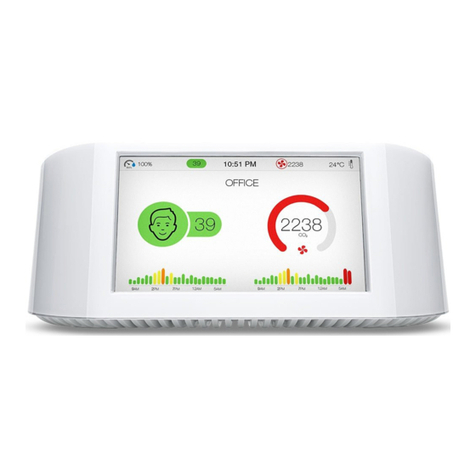
IQAir
IQAir AirVisual Pro user manual
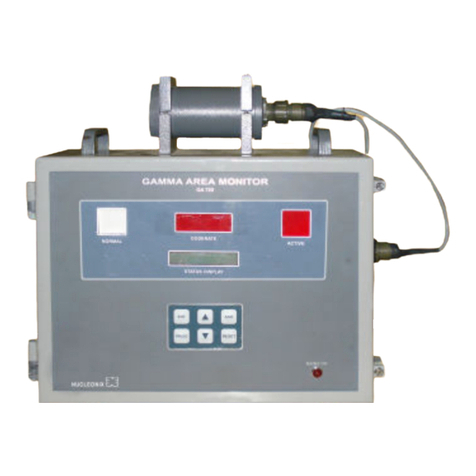
NUCLEONIX SYSTEMS
NUCLEONIX SYSTEMS GA720 instruction manual
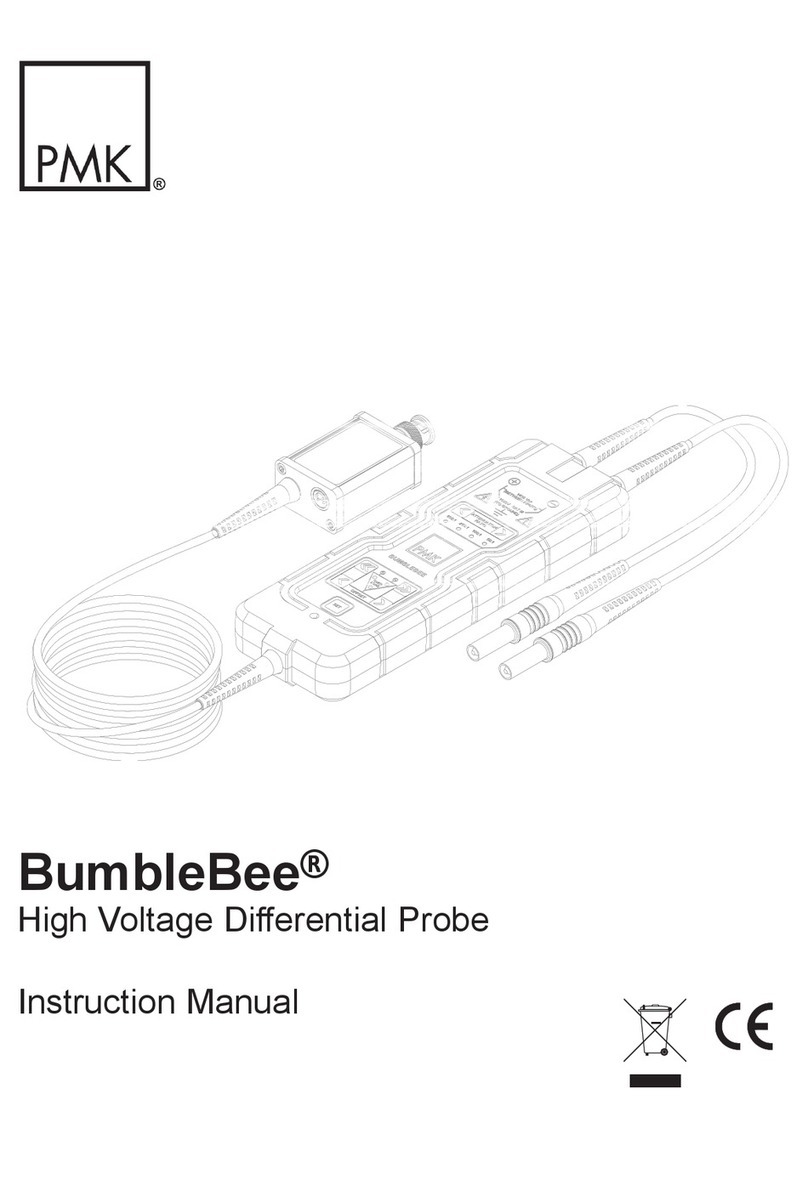
PMK
PMK BumbleBee instruction manual
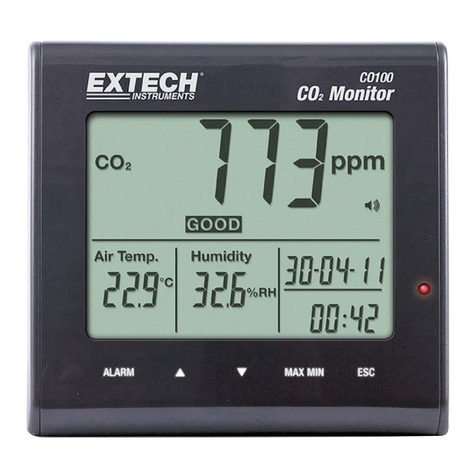
Extech Instruments
Extech Instruments CO100 user manual
